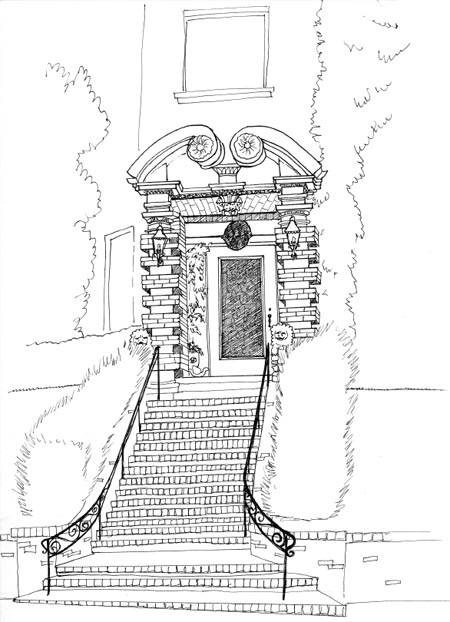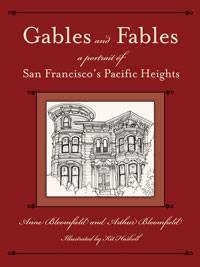Coxhead at Play: Difference between revisions
m (Protected "Coxhead at Play" ([edit=sysop] (indefinite) [move=sysop] (indefinite))) |
(fixed broken link due to page move) |
||
| Line 11: | Line 11: | ||
The original owner of 2800 Pacific was one Sarah Spooner, a wealthy art collector who had arrived recently from Philadelphia. Certainly no expense was spared in the design and construction of her house. Imagine the paintings that hung in this super Coxhead. Well, Ms. Spooner was not long on the scene, because by the time of the ’06 earthquake and fire Matilda and Herman Shainwald were in residence. He was head of a large real estate company, Shainwald Buckbee, which later evolved into the prominent Buckbee Thorne and Co. | The original owner of 2800 Pacific was one Sarah Spooner, a wealthy art collector who had arrived recently from Philadelphia. Certainly no expense was spared in the design and construction of her house. Imagine the paintings that hung in this super Coxhead. Well, Ms. Spooner was not long on the scene, because by the time of the ’06 earthquake and fire Matilda and Herman Shainwald were in residence. He was head of a large real estate company, Shainwald Buckbee, which later evolved into the prominent Buckbee Thorne and Co. | ||
Then in 1914 the property came into the hands of John A. McGregor and remained in the same family for fifty-three years. A Canadian of [[The Immigrants|Scottish ancestry]], McGregor had worked for U.S. Shipbuilding in the East and became in due course treasurer of [[From Pastures to Industry|Bethlehem Steel Corporation]]. When Bethlehem’s shipbuilding division bought San Francisco’s old [[Shipyards in Decay | Then in 1914 the property came into the hands of John A. McGregor and remained in the same family for fifty-three years. A Canadian of [[The Immigrants|Scottish ancestry]], McGregor had worked for U.S. Shipbuilding in the East and became in due course treasurer of [[From Pastures to Industry|Bethlehem Steel Corporation]]. When Bethlehem’s shipbuilding division bought San Francisco’s old [[Shipyards in Decay|Union Iron Works]] in 1905, retaining that name, McGregor soon became its president. | ||
Union Iron Works had been launched in 1849 as the foundry of the Donahue Brothers to whom the [[Douglas Tilden: Monument Sculptor|Mechanics Monument]] at Bush, Battery and Market Streets was dedicated. After a profitable spell on First Street south of Market, and with new owners Henry and Irving Scott, the company moved to Twentieth and Illinois, aka Pier 70, in the 1880s, the better here to build ships. Their huge brick machine shop and administration building are at this location still, along with later buildings put up by Bethlehem. | Union Iron Works had been launched in 1849 as the foundry of the Donahue Brothers to whom the [[Douglas Tilden: Monument Sculptor|Mechanics Monument]] at Bush, Battery and Market Streets was dedicated. After a profitable spell on First Street south of Market, and with new owners Henry and Irving Scott, the company moved to Twentieth and Illinois, aka Pier 70, in the 1880s, the better here to build ships. Their huge brick machine shop and administration building are at this location still, along with later buildings put up by Bethlehem. | ||
Latest revision as of 18:52, 25 March 2019
Historical Essay
by Anne Bloomfield and Arthur Bloomfield
2800 Pacific Avenue, a Georgian gem designed by Ernest Coxhead in 1899, shows off this maverick architect’s love of toying with scale and contrast.
Illustration: Kit Haskell
The original owner of 2800 Pacific was one Sarah Spooner, a wealthy art collector who had arrived recently from Philadelphia. Certainly no expense was spared in the design and construction of her house. Imagine the paintings that hung in this super Coxhead. Well, Ms. Spooner was not long on the scene, because by the time of the ’06 earthquake and fire Matilda and Herman Shainwald were in residence. He was head of a large real estate company, Shainwald Buckbee, which later evolved into the prominent Buckbee Thorne and Co.
Then in 1914 the property came into the hands of John A. McGregor and remained in the same family for fifty-three years. A Canadian of Scottish ancestry, McGregor had worked for U.S. Shipbuilding in the East and became in due course treasurer of Bethlehem Steel Corporation. When Bethlehem’s shipbuilding division bought San Francisco’s old Union Iron Works in 1905, retaining that name, McGregor soon became its president.
Union Iron Works had been launched in 1849 as the foundry of the Donahue Brothers to whom the Mechanics Monument at Bush, Battery and Market Streets was dedicated. After a profitable spell on First Street south of Market, and with new owners Henry and Irving Scott, the company moved to Twentieth and Illinois, aka Pier 70, in the 1880s, the better here to build ships. Their huge brick machine shop and administration building are at this location still, along with later buildings put up by Bethlehem.
The plant built ships for World Wars I and II, and ship repair still goes on there.
Now, John McGregor was very civic minded and sat on the city’s Park Commission (1912–18) and the Board of Supervisors (1922–26), and was also involved with the Symphony, the Boy Scouts, Calvary Presbyterian Church, etc., etc. And he loved baseball.
Reprinted from Gables and Fables: A Portrait of San Francisco’s Pacific Heights by Anne Bloomfield and Arthur Bloomfield. Illustrations by Kit Haskell. [1]
© 2007. Heyday Books, Berkeley, California.


